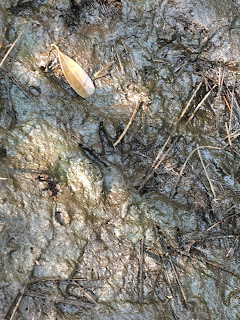Tarpon Springs, FL
Our trip to Brooker Creek was on another nice day. I had never been to Brooker Creek Preserve and my first impression was a good one. It was a nice drive to get to the shelter that we were meeting at and then the trail we took around the preserve was nice. Brooker Creek is the largest preserve in Pinellas County and is approximately 8,000 acres. About 55% of the preserve is upland and 45% are wetlands and some of the preserve consists of hammocks. When we got started walking around the park, the first thing we noticed on the boardwalk was that on one side of the boardwalk was wet and the other side was dry. There was even different types of vegetation literally due to a few inches different elevation. The slight drop in the elevation allowed the water to pool and be more of a swamp area than a hammock. Some plants that are characteristic of a swamp include bald cypress that have "knees" that are their pnematophores and allow for gas exchange when the water levels are high. Other plants in a swamp are ferns and mosses. Both of these plants require a moist environment for their reproduction.
As we walked along the boardwalk, we talked about what characteristics are used to determine what a swamp is. The hydroperiod is important because it refers to how long the water, amount of water, and how fast the water evaporates between flooding. Determining where the water comes from in a swamp is also important because it can tell us what kind of swamp it is. One particularly interesting detail that I learned on this trip was that peat is formed in swamps and that it is a huge form of carbon storage in the environment. It gave me something to think about because a huge problem in climate chage is that there is too much carbon in the atmosphere and I never thought about ways that carbon was stored. Coal was an obvious one but I didn't think about the significance about peat, I thought its main function was to help maintain the water from draining.
Once we reached a shelter on the path, we took a seat to talk about hammocks and high pine grasslands. The picture above depicts a high pine grassland. High pine grasslands are fire dependent communities. Fires, which are usually caused by lightning, burn the dead underlying brush and put those nutrients back into the soil. The pines are not harmed by the fires due to their insulated bark and high up canopies. Often times, the bark on the pines can be seen to be charred from previous fires. This can be seen in the picture at the bottom. When there is no fire in these environments, hardwoods become more common. This can pose a problem because hardwoods burn completely in fires and can burn too hot and long, causing other plants in this community to burn with them that would not normally burn in a quick fire.
This is a Golden Orb Weaver spider. They are non aggressive spiders.
Pictured here are animal tracks, most likely raccoon, in the marsh part of the trail. Raccoons are common in these environments, as they like to scavenge for food.
This pine tree has been charred around the trunk from a fire. Due to the insulation from the bark, the pine does not burn in the presence of a fire. Fires are beneficial in these communities because they get rid of the dead plants and recycle the nutrients back into the soil.




No comments:
Post a Comment